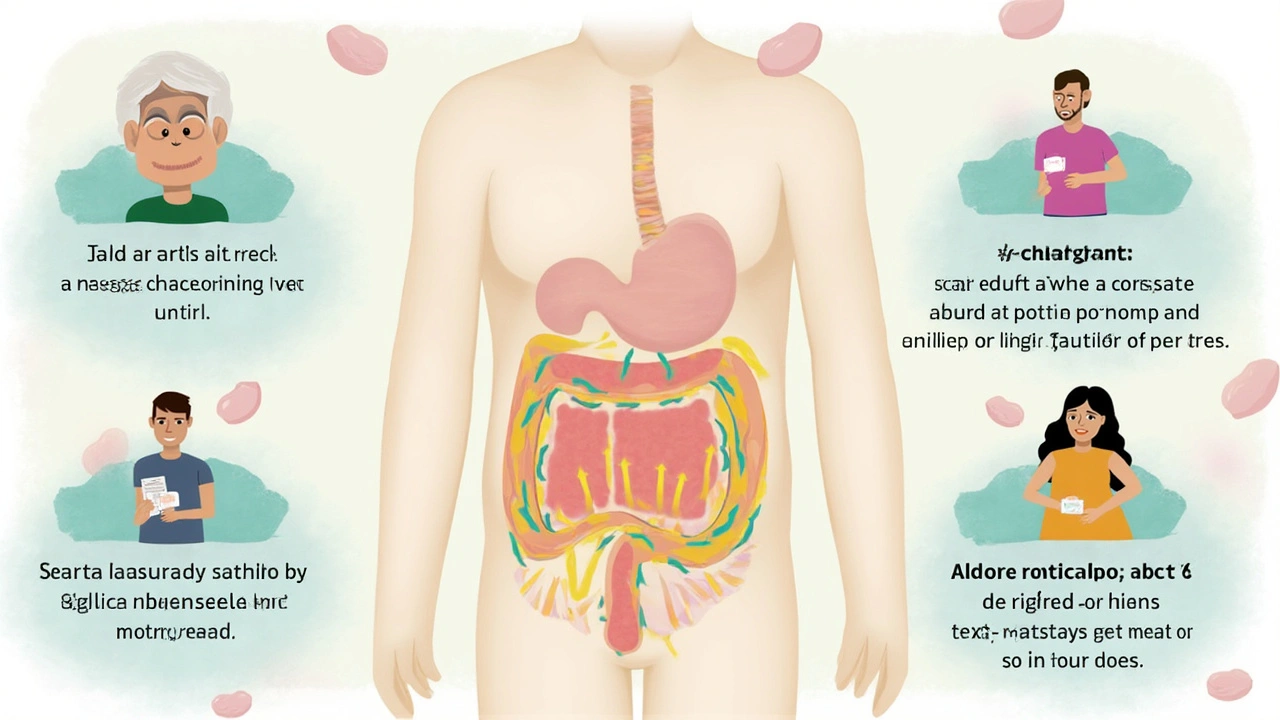Kytril: Guide to Uses, Side Effects & Tips for Nausea Relief
17 Jun, 2025If you’ve ever watched a loved one battle through cancer treatment or faced the awful rollercoaster of nausea yourself, you may have heard of Kytril. Nausea after chemotherapy or radiation doesn’t just make someone uncomfortable—it can keep them from eating, sleeping, or keeping up with daily life. Here’s the thing: not every medication for nausea does the trick, but Kytril, known by its generic name granisetron, is often the secret weapon when other anti-nausea meds fail miserably. And it doesn’t just help chemotherapy patients. It’s also used after surgery, and for those who deal with this relentless, gut-twisting nausea, Kytril feels like a game changer.
How Kytril Works: The Science in Simple Terms
Most people don’t care about the chemistry of what’s going inside their bodies—but getting the basics can make all the difference when side effects pop up, or a doctor gives you a choice. Kytril (granisetron) belongs to a group of drugs called selective 5-HT3 receptor antagonists. Bit of a mouthful, right? Here’s what that really means: Certain nerves in your gut and brain use a chemical messenger called serotonin to trigger nausea and vomiting. That surge of serotonin is what makes chemo patients start retching or feel dizzy after anesthesia. Kytril blocks those serotonin signals between the gut and the brain, so the message to throw up never gets through.
Kytril comes in a few forms: usually as a tablet or through an IV, but there’s also an oral solution and a patch. For many people, it’s taken about an hour before chemotherapy, and then sometimes for a couple of days after. The timing isn’t random—researchers have figured out when the risk for nasty nausea peaks, and that’s when Kytril is at its best.
Why Kytril and not some other antiemetic, like ondansetron? Studies show Kytril is just as effective for certain patients, sometimes even working better in those who didn’t respond to other drugs. Its side effects can also be a bit milder for some people, especially regarding headaches or constipation. That’s a big deal when you’re already feeling wiped out by treatment. Side note: it doesn’t make you drowsy, so you can stay alert and not feel knocked out, which is huge if you want to keep your routine as normal as possible.
Facts at a glance? Check out this overview of Kytril’s clinical performance versus other nausea meds:
| Medication | Typical Uses | Common Side Effects | Onset of Action |
|---|---|---|---|
| Kytril (granisetron) | Chemotherapy, Radiation, Post-Surgery | Headache, Constipation, Fatigue | Within 1 hour |
| Ondansetron (Zofran) | Chemotherapy, Radiation, Post-Op | Headache, Tiredness, Hiccups | 30 min – 2 hours |
| Metoclopramide | Chemo-related, Gastroparesis | Drowsiness, Restlessness, Diarrhea | 30 min – 60 min |
| Aprepitant | Chemotherapy | Hiccups, Fatigue, Heartburn | Few hours |
Doctors choose Kytril for patients who need quick relief and can’t afford too many extra troubles from side effects. For kids going through cancer treatment, it also gets used because there’s data showing it works well with few safety concerns.
If you’re someone who likes understanding the fine print, Kytril is not a cure for cancer, but for symptom management, it can be life-changing. Taking it as prescribed boosts its effectiveness—missing doses, or taking it too late, might mean the drug can’t put out the fire of nausea before it flares up. If genetic factors mean a typical dose isn’t helping, some doctors use higher doses or combine it with other medications, all carefully tailored to maximize relief.

Who Can Benefit from Kytril: Beyond the Chemo Chair
While the big headlines focus on cancer patients, the ways Kytril gets used might surprise you. Maybe you thought anti-nausea meds were just a “chemo thing,” but anyone who’s dealt with gut-churning nerves before surgery or can’t keep food down after a major operation might run into granisetron too. The idea behind this is fairly straightforward: if your body interprets stress, medication, or physical trauma as a reason to sound the nausea alarm, it’s basically serotonin at work. Block it at the right spot, and you’ve got relief.
You might also hear stories about Kytril’s use in severe morning sickness. This is pretty off-label and not the first-line option for expectant moms, but in cases where mom can’t keep any food or liquid down, and nothing else works, some OBs will go with granisetron. Same for patients prone to cyclic vomiting syndrome, or certain types of migraines that come with hardcore vomiting episodes; doctors sometimes reach for Kytril if standard medications fail. Dogs and cats with cancer? Yep, some veterinarians use granisetron, too—that’s how broad its action is.
Now, there are things you don’t want to mess around with. Kytril isn’t for everyone. For example, it should be used with caution in people with certain heart conditions or those already taking meds that affect heart rhythm. People with severe constipation or bowel blockages should flag that to their doctor right away, since Kytril can slow down the gut even more. And let’s be clear: if you’ve had allergic reactions to granisetron or similar drugs, don’t risk it.
Here’s a quick list of people who might get Kytril prescribed:
- Cancer patients facing chemotherapy or radiation (especially if previous antiemetics failed)
- Adults going through tough post-surgery recoveries (general anesthesia can really twist up your stomach)
- Pediatric cancer patients with relentless vomiting
- People with certain unusual conditions, like refractory morning sickness or cyclic vomiting syndrome
- Veterinary use for animals after cancer therapy (with specific dosing)
One study in 2023 pointed out granisetron helps nearly 65% of chemo patients experience “complete response” to nausea—meaning not a single episode during those critical first 24 hours after a round of chemo. If you compare that with the old-school drugs from a couple of decades ago, that’s a massive quality-of-life upgrade. Now, it doesn’t help every single patient, and some need combo therapy, but for many, it’s the key that finally unlocks their appetite and sleep.
Managing expectations is important here. Kytril doesn’t wipe out all nausea for everyone. Eating small meals, staying hydrated, and using other strategies alongside medication can help. Keep an eye out for side effects like headache or mild constipation, common with this medication. For most, the trade-off seems worth it: imagine not dreading every meal or glass of water.

Practical Advice, Side Effects, and What to Watch For
Let’s talk side effects straight without scare tactics. The good news: Kytril is usually tolerated well—way better than older nausea medications that could knock you out or make you groggy. The most frequent issues? Headaches and constipation. Sometimes there can be a bit of fatigue, but it doesn’t generally leave folks wiped out. Still, any new medication comes with stuff to watch for. If after a few days you’re feeling seriously backed up, it’s worth calling your doctor; they can suggest tricks to keep things moving, from upping fluids, adding gentle laxatives, or tweaking other meds. For headaches, basic pain relief works for most.
Very rarely, Kytril can subtly slow down your heart’s electrical system (QT prolongation). If you’re taking other meds with that risk or have had heart rhythm trouble before, that’s a conversation to have upfront with your medical team. Allergic reactions are rare but serious—trouble breathing, swelling, or rash means you should seek help immediately.
Something you might not know—Kytril isn’t meant to prevent motion sickness. People sometimes hope a leftover tablet will help on a bumpy flight, but studies haven’t shown much benefit here. Save it for its real job: defeating powerful nausea from advanced treatments or surgeries.
Pro tips for anyone starting Kytril:
- Take Kytril at the exact time your provider tells you—even 30 minutes too late can start a spiral of symptoms that’s hard to stop.
- Stay ahead of constipation. Fiber-rich foods, extra hydration, and (if needed) a gentle stool softener make a big difference for many.
- If you miss a dose, take it as soon as you remember, unless it’s almost time for your next one—then skip, don’t double up.
- Let your medical team know all the meds you’re taking, even the vitamins. Kytril plays well with most, but the more info, the better.
- Don’t break or crush the tablet unless your pharmacist or doctor gives the green light—formulation matters for how it works in your body.
Cost-wise, granisetron (the generic) is now widely available, shrinking the price down compared to a decade ago. Insurance usually covers it if you’re in the middle of chemo or other qualifying therapies; some plans even cover the Kytril patch for those who can’t swallow pills or need long-term action.
One overlooked point: if you’re caring for someone on Kytril, keep track of how well it’s working. Is their appetite coming back? Can they keep up their fluids? If nausea or vomiting breaks through your medication plan, sometimes it just takes one conversation with the care team to adjust the timing or try a different formulation. Don’t “tough it out”—that’s not what this medication is for. Life with cancer or surgical recovery is tough enough already; managing nausea shouldn’t be another battlefield.
At the end of the day, Kytril is one of those modern medicines that quietly saves the day for people who feel like they’ve run out of options. Whether you’re a patient, family member, nurse, or just someone who loves knowing how these “behind the scenes” medications work, it’s a small tablet with a huge impact on the fight against the worst kind of nausea—and that means more good days, even when life’s at its toughest.

Pat Mills
July 18, 2025 AT 07:52Oh, wonderful! Finally, someone decided to put all the info about Kytril in one place. Honestly, I don’t understand how people survive chemo-induced nausea without this stuff. It’s like a lifesaver, nay, a blessing from modern medicine itself.
Let me tell you, granisetron isn’t just some run-of-the-mill drug. It’s a powerful serotonin 5-HT3 receptor antagonist that, once it hits your system, basically tells your brain to chill out and stop the nausea rollercoaster. The precision is remarkable—truly a marvel of pharmaceutical science!
I’d love if the guide included more detail on how to adjust doses for different patient profiles because not everyone reacts the same way. But overall, this is an enlightening resource that should be mandatory reading for patients and caregivers alike.
Also, the list of side effects? A necessary evil, yes, but they paint a much clearer picture of what to expect. It helps remove the stigma and fear surrounding anti-nausea meds.
Anyway, keep this coming! Education is power, and this guide packs a punch of it.
neethu Sreenivas
July 22, 2025 AT 20:44This guide really hits the mark on being empathetic towards those suffering from nausea, which is such a miserable sensation. 😊 It’s so important to feel supported when dealing with something that can make even the smallest tasks unbearable.
I particularly appreciate the detailed breakdown of side effects and how to manage them. It’s validating for anyone who’s had to deal with less talked about symptoms, and it gives caregivers the tools to provide better comfort and care.
The advice on practical tips is gentle yet insightful, begging the question—how often do patients receive this kind of compassionate informational support in clinical settings? So often, this kind of knowledge feels inaccessible or overwhelming.
Thanks for putting this together in such a clear, digestible manner. It takes a thoughtful approach to balance factual content with emotional resonance. 🙏
Keli Richards
July 29, 2025 AT 23:17Good guide, really straightforward and well organized. I like how it explains what Kytril does without resorting to too much medical jargon, which makes it accessible to folks who might be overwhelmed when they look up meds.
One thing I noticed is that it might also be helpful to add some user experiences or testimonials for perspective because understanding how people felt on the medication can sometimes make a big difference for those just beginning treatment.
Also, mentioning how Kytril compares to other anti-nausea meds could enrich the discussion, you know? Like when do doctors choose this one over alternatives?
In general, though, solid and helpful. Thanks for sharing.
Ravikumar Padala
August 2, 2025 AT 05:37Yeah, uh, so this post pretty much covers the basics of Kytril, uh, which is nice 'cause sometimes you get confused with all the meds out there. But ya know, it kinda leaves you hanging on some stuff, like, what about different administration methods or impacts on patients with other health issues? That would be useful.
Also, I've heard that sometimes these anti-nausea meds have delayed effects or interact weirdly with other drugs. The guide touches on side effects but could go deeper into that part.
Still, guess this is a reasonable starting point if you just wanna know what Kytril is about and what to expect. Kinda makes me wish there was a quick synopsis at the start for those who skim things.
King Shayne I
August 3, 2025 AT 07:44Not gonna sugarcoat it, this read was pretty good but left me wondering about some more aggressive questions. For example, how often do patients really experience the worst side effects and should there be more caution flags?
If we're talking safety, I feel like the nuances of drug interactions with other medications and supplements should be spelled out much clearer.
Patients have enough on their plate without guessing what might send them to the ER. So IMO, more emphasis on when to call your doc immediately would be a solid addition.
Still, credit where it’s due — the guide doesn’t hide the downsides, it talks about them pretty openly. That’s refreshing these days.
jennifer jackson
August 5, 2025 AT 11:30I'm so glad I found this guide! It’s reassuring to have a clear, calm source of info about Kytril. Often folks feel so overwhelmed when battling nausea, but this breaks things down gently.
It’s helpful that the guide talks about tips for both patients and caregivers — they really need to work together for the best results and comfort. I believe with the right support, managing nausea is much less scary.
Feeling hopeful and encouraged to share this with some folks I know going through it! Keep posting positive and helpful stuff like this.
Brenda Martinez
August 8, 2025 AT 13:17Seriously, I can’t expect people to understand the full picture of Kytril just from one guide. It barely scratches the surface of what this drug does, and frankly, it romanticizes the whole experience.
Nausea is a brutal, soul-sapping hellhole, and while Kytril helps, it’s not a miracle cure by any stretch. I’ve seen people suffer terrible side effects that this post kind of glosses over like they’re minor inconveniences. That’s BS.
Why not really tell it like it is? Patients deserve the full honest truth instead of some watered-down cheerleading pamphlet.
And let’s be real: if you’re on this medication, you’re already in a pretty rough spot. Stop pretending it’s all peaches and cream.
Marlene Schanz
August 10, 2025 AT 15:17I find this guide fairly balanced and informative, though I did notice a couple of minor typos here and there. Nothing too distracting, just the kind of casual slip-up you see in online articles.
For those who haven’t tried Kytril yet, it’s useful to know that while it effectively blocks nausea, some people might feel tired or constipated initially. These are pretty manageable side effects if you ask me.
It’d be great if the author could add a small FAQ section for common questions that come up with first-time users.
Overall, it’s a chill, helpful resource for anyone wanting the basics without drowning in medical complexity.
Matthew Ulvik
August 12, 2025 AT 23:40This is a really nice post that explains Kytril in simple terms :) For people new to this medication, such clarity is super helpful. I've personally seen how nausea can just tank your day, and meds like Kytril are a blessing.
Just always remember to check in regularly with your healthcare provider to make sure you’re getting the best dose and monitoring side effects properly.
Does anyone here have personal stories on how Kytril helped or didn't help you? 🙂 It’s always good to hear real-world experience!
Dharmendra Singh
August 15, 2025 AT 06:07Appreciate the guide, especially for patients in regions where medical advice is less accessible. Kytril is well-known here but sometimes the cultural stigma around anti-nausea drugs makes it hard to discuss openly.
One thing to add is to remind patients to discuss with their doctors about combining Kytril with local herbal remedies, since interactions may occur.
A suggestion for the post: including simple diagrams or visuals might help convey the drug’s mechanism better for those who learn more visually.
Rocco Abel
August 16, 2025 AT 05:27Look, I won’t beat around the bush here — this guide looks pretty textbook, but the real question is, who’s funding this content? Big pharma has their fingers in everything, and Kytril is no exception.
Readers need to be cautious and consider alternative therapies because they aren’t going to advertise the potential risks fully. Side effects are always underplayed.
And the over-reliance on such medicines without questioning the systemic issues in treatment approaches is exactly what keeps us stuck. Stay skeptical people.
Pat Mills
August 17, 2025 AT 06:27@Brenda, I get that the experience can be rough and the guide won't capture every nuance of suffering, but having detailed, well-organized info versus nothing is huge. It’s not about sugarcoating pain but empowering through knowledge.
The article clearly calls out side effects, and I think that honesty is vital. Maybe the emotional impact warrants a separate companion piece.